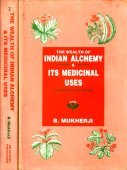Rasayanatantra, Rasayana-tantra: 3 definitions
Introduction:
Rasayanatantra means something in Hinduism, Sanskrit. If you want to know the exact meaning, history, etymology or English translation of this term then check out the descriptions on this page. Add your comment or reference to a book if you want to contribute to this summary article.
In Hinduism
Ayurveda (science of life)
Source: Google Books: Cultural Leaders of India - Scientists (Ayurveda)Rasāyanatantra (रसायनतन्त्र) refers to “geriatrics” and represents one of the eight divisions (aṣṭāṅga) of Āyurveda as divided by Dhanvantari.—Accordingly, Dhanvantari became a pupil of sage Bhāradvāja who taught him Āyurveda and Bheṣakriyā. Later, Dhanvantari is stated to have divided the entire range of Āyurveda into eight divisions (the Aṣṭāṅgas), each division representing a speciality. These specialities are [viz., 7. Rasāyanatantra (geriatrics), ...]. In his turn, he is stated to have imparted the knowledge of these specialities to his pupils.

Āyurveda (आयुर्वेद, ayurveda) is a branch of Indian science dealing with medicine, herbalism, taxology, anatomy, surgery, alchemy and related topics. Traditional practice of Āyurveda in ancient India dates back to at least the first millenium BC. Literature is commonly written in Sanskrit using various poetic metres.
General definition (in Hinduism)
Source: Wisdom Library: HinduismRasāyana tantra (रसायन तन्त्र):—Sanskrit compound word which translates to “treatment with chemicals”. Used in Āyurveda and such works.
Languages of India and abroad
Sanskrit dictionary
Source: Cologne Digital Sanskrit Dictionaries: Monier-Williams Sanskrit-English DictionaryRasāyanatantra (रसायनतन्त्र):—[=rasāyana-tantra] [from rasāyana > rasa > ras] n. Name of [work]
Sanskrit, also spelled संस्कृतम् (saṃskṛtam), is an ancient language of India commonly seen as the grandmother of the Indo-European language family (even English!). Closely allied with Prakrit and Pali, Sanskrit is more exhaustive in both grammar and terms and has the most extensive collection of literature in the world, greatly surpassing its sister-languages Greek and Latin.
See also (Relevant definitions)
Partial matches: Rasayana, Tantra.
Query error!
Relevant text
Search found 16 books and stories containing Rasayanatantra, Rasāyana-tantra, Rasayana-tantra, Rasāyanatantra; (plurals include: Rasayanatantras, tantras, Rasāyanatantras). You can also click to the full overview containing English textual excerpts. Below are direct links for the most relevant articles:
Notices of Sanskrit Manuscripts (by Rajendralala Mitra)
Page 182 < [Volume 9 (1888)]
Vakyapadiya of Bhartrihari (by K. A. Subramania Iyer)
Verse 1.5 < [Book 1 - Brahma-kāṇḍa (or Āgama-samuccaya)]
International Ayurvedic Medical Journal
Role of rasayana therapy in geriatric disorder < [2016, Issue X October]
Rejuvenating and clarity enhancing effects of special senses with reference to the role of anutaila nasya < [2020, Issue 6, June]
Conceptual study of rasayana < [2016, Issue II February]
Informal Education of Sanskrit in Kerala (by Jayasree M.)
4. The Astavaidyans of Kerala < [Chapter 5 - Sanskrit and Ayurveda: Role of Informal education]
Influence of Nyaya-Vaisesika on Ayurveda (by Sindhu K. K.)
15. Ayurveda and Samhita period (period of Compilations) < [Chapter 1 - Origin and Development of Nyaya-Vaisesika and Ayurveda]
Review on rasayana and nutraceuticals for diabetes management. < [Volume 3, issue 5: September - October 2016]
Rasayana with special reference to nutraceuticals: a comparative study < [Volume 4, issue 1: January - February 2017]
Srisailam's Role in Ayurveda's Medieval Historical Progress < [Volume 11, Issue 3: May-June 2024]
Related products
